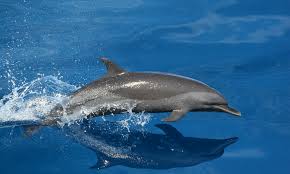Peale’s Dolphins, scientifically termed as Lagenorhynchus australis, are a captivating species of dolphins that inhabit the cool waters around the Falkland Islands and the southern tip of South America. Known for their playful demeanor and striking black, gray and white coloration, they are a significant presence in their maritime ecosystems. This document is dedicated to exploring the interesting facets of these marine mammals, their habitat, behavior, and the role they play in the biodiversity of their environment.
Reproduction and Birthing Rituals
- Breeding Season: Peale’s dolphins’ breeding season typically spans between October and April. During these months, the dolphins engage in courtship rituals and mating, culminating in successful fertilization.
- Gestation Period: After fertilization, the female Peale’s dolphin experiences a gestation period of approximately 10 to 12 months. This period allows the calf to fully develop inside the womb, preparing it for life in the ocean.
- Single Calf Birth: The birthing process of Peale’s dolphins usually results in the birth of a single calf. This event is a significant moment in the life cycle of these marine mammals, emphasizing the species’ investment in the success of each offspring.
- Nursing Period: Following birth, the calf enters a nursing period that can last up to one and a half years. During this phase, the calf is heavily dependent on its mother’s milk for nutrition and antibodies that provide immunity from diseases. This period is crucial for the calf’s growth and development before it can independently hunt and feed.
Lifespan of Peale’s Dolphins
- General Dolphin Lifespan: Dolphins, as a species, typically live for quite a long time in the wild, with many reaching an age of up to 20 years. Some larger species, such as the Orca or ‘Killer Whale’, have been known to reach ages exceeding 50 years. These figures, however, can vary quite significantly across different dolphin species.
- Lack of Specific Information: When it comes to Peale’s Dolphins, there’s a significant lack of specific information regarding their lifespan in the wild. Due to their remote and often inaccessible habitats, coupled with their elusive nature, it has been challenging for researchers to gather comprehensive data on the life expectancy of these particular dolphins. As a result, their precise lifespan remains a topic open for further exploration and discovery.
Related Post : Irrawaddy Dolphin Overview
Population Estimate
Peale’s Dolphins, scientifically known as Lagenorhynchus australis, are a captivating species largely unfamiliar due to scanty data on their population. Several reasons contribute to the lack of official population estimates:
- Limited Research: The secluded habitat of Peale’s Dolphins, predominantly in the sub-Antarctic waters, makes them challenging to study. Despite their relative commonness in suitable habitats, extensive research on them is not readily available.
- Insufficient Funding: Financial constraints often limit extensive marine mammal research. The vastness of the dolphins’ habitat requires significant resources for comprehensive study.
- Variable Distribution: Peale’s Dolphins are distributed unevenly across their range, making it difficult to establish accurate population assessments.
The absence of official estimates, however, does not undermine the importance of monitoring these species. Regular monitoring is vital to identify potential threats, understand their impact, and develop effective strategies to ensure the survival and growth of the Peale’s Dolphins population. Conservation efforts hinge on this understanding to protect and sustain biodiversity in our oceans.
Natural Predators and Human-Induced Threats
- Limited Information on Predators: The natural predators of Peale’s Dolphins remain a mystery due to the lack of comprehensive research in this area. Predatory threats could potentially include larger marine species and sharks, but without extensive observational data or studies, it is difficult to ascertain the precise nature of these interactions.
- Human-Induced Threats: Peale’s Dolphins face significant dangers caused by human activity. Fishing expeditions pose a significant risk, as these dolphins can become entangled in fishing nets and equipment, often leading to injury or death. Additionally, pollution, particularly plastic waste and toxic chemicals, severely impact marine ecosystems. These pollutants can harm the dolphins directly by ingestion or indirectly by damaging their food sources.
Additional Profound Peale’s Dolphin Facts
- Unique Whistling Behavior: Unlike many other dolphin species, Peale’s Dolphins exhibit a unique lack of whistling behavior. This distinct characteristic is an area of ongoing research among marine biologists, contributing to the fascinating complexity of their communication patterns.
- Largest in the Genus: Standing out among the genus Lagenorhynchus, Peale’s Dolphins are noteworthy for being the largest species in the Southern Hemisphere. Their impressive stature further distinguishes them within the extensive family of dolphins.
- Titian Ramsay Peale Connection: Named after the American explorer Titian Ramsay Peale, these dolphins hold historical significance linked to Peale’s 1848 observation. This connection adds a layer of intrigue to their scientific classification, intertwining their biological identity with the annals of exploration history.
Conclusion
- Reproductive habits: Peale’s Dolphins, like many cetaceans, have distinct mating seasons, with the majority of births occurring in the warmer months. This reproductive pattern allows calves to grow and gain strength during the most hospitable season.
- Lifespan: These dolphins are known to live for up to 20 years in the wild, though exact lifespans can vary based on factors such as habitat quality and food availability.
- Population status: Current data on the Peale’s Dolphin population is somewhat limited, but these creatures are not currently listed as endangered. However, any significant changes to their environment could potentially threaten their numbers.
- Unique characteristics: Peale’s Dolphins are easily recognizable due to their distinctive black and white markings. They are highly social animals, often seen in groups and known for their playful behavior.
- Importance of conservation efforts: Continued research and conservation efforts are vital to maintaining healthy populations of Peale’s Dolphins in the wild. These initiatives can help protect their habitats, ensure sustainable food sources, and address potential threats from climate change and human activities.

